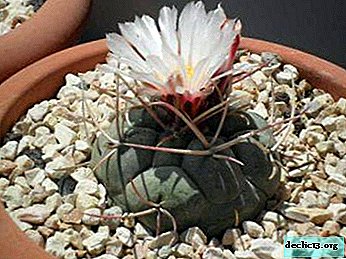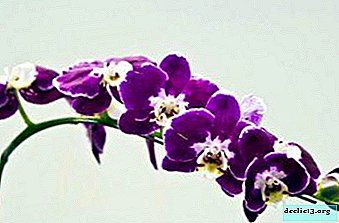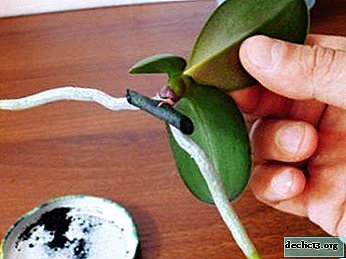Exotic telocactus of bizarre beauty - description, main types with photos and rules of care

Recently, telocactus are gaining more and more popularity among gardeners and collectors.
Consider the plant in more detail and understand the rules for caring for a flower, and also visually on the photo we will see the most common types of this cactus and compare varieties among themselves.
This article describes in detail how to properly propagate telocactus using seeds, as well as detail how to properly grow these amazing plants in open ground.
Botanical Description
Telocactus is a whole genus of plants in the Cactus familyto which about 20 species belong. The bizarre beauty and captivating unpretentiousness of these exotic flowers have long earned them unprecedented popularity and a reliable place on the windowsills and in the hearts of botanists around the world.
Other names: Echinocactus leucacanthus (generally accepted scientific name of the genus until 1898) .Latin name: Thelocactus.
History of origin: The first representative of the Telocactus genus was discovered by William Karwinsky near Zimapan (Mexico) and sent to the Munich Botanical Garden in 1830.
 However, official recognition and inclusion in the general classification as a separate genus occurred only thirty years later, thanks to the work of Britton and Rose. These outstanding biologists have significantly expanded the boundaries of Thelocactus, describing many of its species.
However, official recognition and inclusion in the general classification as a separate genus occurred only thirty years later, thanks to the work of Britton and Rose. These outstanding biologists have significantly expanded the boundaries of Thelocactus, describing many of its species.
Currently, research is actively ongoing under the auspices of the International Group of Cactus Systematics (ICSG), and new types of telocactus are still being opened.
Morphology:
- The stem is spherical or cylindrical, solid, spirally divided into many ribs covered with large tubercles. Height - from 5 cm to 20 cm. Diameter - up to 20 cm.
- Spikes radial are needle-shaped, pressed against the stem. The length is from 1.5 cm to 3 cm. The central thorns are sometimes absent, but most often they are available in an amount of one to four. Length - from 3 cm to 4 cm. All spines are brightly colored in yellow-red or brown.
- The flowers are small in size but impressive in color. Most often - in the pink spectrum, but there are specimens with flowers of yellow and white shades. Diameter of flowers - from 3 cm to 9 cm.
- The fruits are small, bare. Seeds are black.
Generally, Telocactus is notable for its very decorative appearance and amazing variety.. Of considerable interest from the point of view of collecting.
Habitat geography:
- Middle and Northern Mexico
- Rio Grande River Areas in Texas (USA).
Popular views with photos
The genus Thelocactus is known for its polymorphism - the plants that make up its composition are strikingly different from each other. Such rampant diversity greatly complicates their classification. But, despite this, there are still common signs.
Hexahedral (Hexaedrophorus)
A single and rather variable cactus with characteristic flattened stems.
The stem is spherical, bluish, olive or grayish-green. Height: 3-7.5 cm. Diameter: 8-15 cm. Ribs are not clearly defined, appearing only in adult plants.
Spines are fleshy, rounded (hexagonal or pentagonal). Length - from 8 mm to 20 mm. Often, the central spines are indistinguishable from radial ones. The colors are pinkish gray, ocher or chestnut. The flowers are silver-white or pinkish with purple. Diameter - up to 25 cm.
It does not require complicated maintenance, but it grows very slowly. Needs good drainage and plentiful watering (from spring to autumn). It easily tolerates temperatures up to -7 ° C. More recently, this species was considered endangered.

Two-tone (Bicolor)
Telocactus bicolor is the most recognizable and popular member of the genus. Another name: Texas Pride.
The stem is spherical or elongated with intensely banded areoles on the tubercles. Ribs slightly wavy, pronounced.
The species name bicolor means bicolor. and refers to the unusual coloring of thorns. They are white with red tips or red with amber-yellow ends. The flowers are large, of varying intensities of pinkish-purple tones. Diameter - up to 10 cm. They look very impressive.

Conothelos (Conothelos)
A distinctive feature is a powerful spherical stem with fuzzy ribs. But the tubercles, rounded or conical, are very pronounced. Plant height - up to 15 cm. Diameter - up to 25 cm. Spines are divided into glassy white radial and reddish-brown or brown-black central.
The flowers are purple or purple, but also orange. Length - about 3.5-4 cm. Fade very quickly (during the day).

Lloyd's hexahedral subspecies (lloydii)
This species has thick stems with thick flat tubercles on polygonal bases. The diameter of the plant is from 8 to 12 cm. Color - from gray to bluish green.
A characteristic feature is the impressive appearance of sharp spines. Their length can be more than 6 cm. The color is reddish-brown at the base and yellow-crimson at the tips. With age, their color noticeably fades. A remarkably beautiful flower in a light pink hue resembles a lotus flower.

Rincon (Rinconensis)
Another well-armed cactus. It has long straight spines (up to 5-6 cm). The stem is single, spherical. Height - 15 cm, diameter - up to 20 cm. Ribs are hardly distinguishable. Conical tubercles, well defined (up to 1.5 cm).
The flowers are small and not too expressive. Diameter - up to 3 cm. Color - from white to pink.

Tula submarine Bek (Tulensis subspecies Buekii)
Neat cactus is relatively small (height up to 15 cm). Body diameter - up to 18 cm. The number and length of spines can be very different. The flowers are bright purple, red-violet, pink. Great for growing in containers.

Home Care
- Temperature mode. Optimum temperature: + 20-25 ° C. In winter, it is recommended to reduce it to 8-15 ° C. It tolerates short-term frosts up to -2 ° C in dry air.
- Watering. During the growth period - abundant watering. In winter - dry content. Does not need spraying.
- Illumination. 3-4 hours of direct sunlight per day; on summer days, slight shading is recommended.
- Soil composition:
- leaf humus (2 parts);
- turf land (1 part);
- coarse river sand or fine stone (1 part);
- ash or crushed coal (1 part).
- Pruning. Too tall, out of shape, cacti need pruning.
- Carefully cut off the top of the cactus with a clean knife (6-8 cm).
- Slightly sharpen the edges of the cut (like a pencil).
- Place the top in a container with a little water.
- After the roots appear, place in a pot with light sandy soil and drainage.
- Water 6 days after planting.
- Fertilizers In spring and summer, feeding is carried out monthly. Fertilizers are preferred special for succulents, high in potassium. In autumn and winter, feeding the plant is not recommended.
 Choosing the right pot. Contrary to popular belief and fashion trends, telocacuses need a large living space and cannot fully develop in mini-pots intended for sale.
Choosing the right pot. Contrary to popular belief and fashion trends, telocacuses need a large living space and cannot fully develop in mini-pots intended for sale.It is recommended immediately after purchase to transplant the plant into a more spacious container.
- Transfer. It is carried out in the spring, every 2-3 years.
- Carefully lay the cactus on its side so as not to damage the thorns, on a piece of foam.
- Separate the earthen lump from the pot.
- Carefully remove excess soil not mastered by the root system.
- Using foam rubber, we place the plant in fresh soil, which is slightly compacted.
- After transplanting, watering is stopped for several days.
Winter care
Telocactus need a cool and calm wintering:
- A gradual decrease in temperature to 8-12 degrees.
- Stop watering and feeding.
Outdoor cultivation
Some types of cacti can be grown outdoors even in the midland of Russia. However, in this case, the following subtleties exist:
- rocky soil is required;
- the ideal place is an alpine hill protected from cold winds;
- complete absence of weeds;
- moderate humidity of the earth.
Seed propagation
 Seeds are sown in the spring:
Seeds are sown in the spring:
- Wash and disinfect the pot thoroughly.
- To sterilize soil with a high sand content at a temperature of 200 - 250 ° C.
- Soak the seeds for a day in a solution of potassium permanganate.
- Place the seeds in the pot with a brush. Cover with polyethylene or glass.
- Place the pot in a warm, bright place.
Features of breeding in open ground:
- the plant is planted exclusively in moderately moist soil;
- watering is possible a week after planting;
- under the stems, drainage of fine gravel is sprinkled;
- unrooted cacti must be protected from direct sunlight.
Diseases and Pests
Violation of the temperature regime, drafts and illiterate watering lead to a weakening of the plant and all kinds of diseases.
The most common:
- root rot;
- mealybug.
Similar flowers
- Monanthes Perennial succulent. Outwardly, it very much resembles a thoracicactus without thorns, but the flowers are located on fairly long pedicels.
- Argyroderma (Argyroderma). A dwarf plant resembling a stone. Argyroderma flowers are strikingly spectacular.
- Faucaria A fleshy plant with a shortened stalk. On the edges of the leaves there are sharp, spike-like outgrowths.
- Guernia (Huernia). It has a low thick stalk with teeth and flowers of the most bizarre shapes and colors.
- Lithops. For its unusual appearance and sudden spectacular flowering, it is often called a "living stone".
It is difficult to find a more unpretentious plant, characterized by the same brightness and variety of forms. At the same time, research work continues and goes to a new level. This means that the genus Thelocactus still exists, than to surprise us!

 Choosing the right pot. Contrary to popular belief and fashion trends, telocacuses need a large living space and cannot fully develop in mini-pots intended for sale.
Choosing the right pot. Contrary to popular belief and fashion trends, telocacuses need a large living space and cannot fully develop in mini-pots intended for sale.















